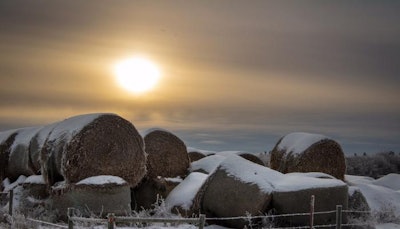
In many parts of the U.S., producers are struggling to find hay and, if they can find it, the price tag isn’t cheap. The shortage may be attributed to last summer's heavy rains that some parts of the country experienced while others dealt with drought. Iowa is no exception.
“Hay and straw continue to be in short supply," the United States Department of Agriculture (USDA) Market News Iowa Hay Summary said for the week ending March 1. "Gravel roads are hard to drive as many only have one lane open, limiting the movement of hay and straw off the farm. Best quality straw and hay continues to be shipped in from out of state. Livestock producers are advertising in weekly papers looking for better quality hay or bedding. The scarcity of good quality hay and straw is forcing producers to cut their livestock numbers.”
On our own cattle operation in Eastern Iowa, we’ve already been buying hay to grind for cows. The three cuttings we got this year wasn't enough in these extreme temperatures. Not to mention, we’ve run out of stalk bales. The extra rain we had this fall didn’t allow us to make as many as we typically would in a year where we probably needed more than normal. In our area, this is a pretty common problem, which means the farmers who have hay and straw don’t want to sell what they have.
The USDA Iowa Hay Summary report said good grass hay in large round bales last week was US$200 to US$250 a bale. In South Dakota, for comparison, good large round bales are US$165 to US$190, according to the High Plains Journal. The same report said hay prices are steady to a bit higher in most of the Western states than what they were last week.
Lucky for us, after multiple phone calls, we found large round bales this week slightly cheaper than what the USDA report said. Here’s hoping it’ll hold us over until the warmer weather comes.
Hay shortages in other areas
Areas on the East Coast, including West Virginia, saw a negative impact to their hay crop due to increased rainfall.
“Due to recent concerns of a potential hay shortage in West Virginia, the West Virginia Department of Agriculture, Farm Service Agency and WVU Extension Services are offering cattle farmers tips on how to maintain a healthy herd,” the High Plains Journal reported.
In North Dakota, what looked like an adequate supply of hay for the winter is becoming questionable in some cases, said John Dhuyvetter, North Dakota State University Extension’s livestock systems specialist at the North Central Research Extension Center near Minot in a News Dakota report. He added that this need for added feed comes after two years of drought that led to a scarcity of hay.
In Texas, “top-quality hay is difficult to find this time of year as producers are cleaning out inventory to make room for new crop,” the USDA Market News Weekly Texas Hay Report said.

















